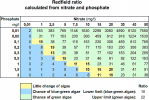Below is an interesting article I found about the importance of maintaining a balance of nutrients in reef aquaria, and the effect it has, especially N : P ratio. Take a look at the chart in the article -

 www.thesaltyside.com
www.thesaltyside.com

The Redfield Ratio - Balancing Nutrients in a Saltwater Aquarium
If you have an 'unbalanced' saltwater tank, you may need to balance your nutrients. Find out how the Redfield Ratio can help.
 www.thesaltyside.com
www.thesaltyside.com

